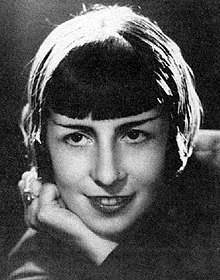fiction.wikisort.org - Writer
María Luisa Bombal Anthes (Spanish pronunciation: [maˈɾi.a ˈlwisa βomˈβal]; Viña del Mar, 8 June 1910 – 6 May 1980) was a Chilean novelist and poet.[1] Her work incorporates erotic, surrealist, and feminist themes. She was a recipient of the Santiago Municipal Literature Award.
María Luisa Bombal | |
|---|---|
 | |
| Born | June 8, 1910 Viña del Mar, Chile |
| Died | May 6, 1980 Santiago, Chile |
| Education | University of Paris |
| Occupation | Writer |
Biography
María Luisa was born in 1910 to Martín Bombal Videla and Blanca Anthes Precht.[2]
As a child Bombal attended the Catholic girls school Sagrados Corazones. After her father's death in 1919, Bombal went with her mother and sisters to live in Paris, where she finished her studies at the lycée Sainte Geneviève. Bombal enrolled at the University of Paris, where she studied literature and philosophy. She also attended the Lycée La Bruyère and the Sorbonne, where she began to write. After Bombal completed her university studies, she returned to Chile, where she reunited with her family.
Bombal also studied violin with Jacques Thibaud and drama with Charles Dolan.[when?]
In 1938 Bombal published La amortajada, which earned her the Premio de la Novela de la Municipalidad de Santiago (City of Santiago Novel Prize). While living in the United States,[why?] she wrote a novel in English, The House of Mist, which was a translation and extensive readaptation of her Spanish-language novel La última niebla.[3] The House of Mist was later translated into Spanish by Lucía Guerra.
Personal life
Upon her return to South America she married a pioneer in civil aviation, Eulogio Sánchez, who did not share her interest in literature. During their marriage, Bombal began to suffer from depression, and attempted suicide. In 1933 she married the homosexual painter Jorge Larco, forming with him a lavender marriage. With the help of friends, Bombal fled the country to Argentina, where in 1933 she met Jorge Luis Borges and Pablo Neruda in Buenos Aires. In 1937 she returned to Chile due to the beginning of a divorce trial. In 1941 she acquired a revolver, went to the Hotel Crillón and waited for Eulogio, her lover.[clarification needed] When he came out, she shot him three times in the arm. She went to trial; however, Eulogio exempted her from all guilt, for which the judge acquitted her. Years later, on María Luisa's own words, she said that he ruined her life, however, she never forgot him. Later on, she moved to United States, where she married the French count, Rafael de Saint Phall, whom she had a daughter with, called Brigitte. She lived there until 1971. She then returned to South America; living first in Argentina (helped by Pablo Neruda, who was also living there), where she met important men of letters, and then in Viña del Mar, Chile. There, on 18 September 1976, Bombal again met Jorge Luis Borges.[3]
Death
Bombal lived her final years in Chile. She became an alcoholic, which led to cirrhosis. Bombal died on May 6, 1980, in Santiago, as a result of gastrointestinal bleeding.[4]
Distinction between femininity and masculinity in her works
Bombal wrote distinctly for her male and female characters. Bombal viewed femininity as a symbol of uniqueness; more related to nature, emotions and intuition; very different from how she depicts masculinity, where men are described as stronger and wiser, at the moment of facing problems.[5]
Selected works
Novels
- La última niebla (1934)
- La amortajada (1938)
- The House of Mist (1947, English readaptation of La última niebla)
- The Shrouded Woman (1947, English readaptation of La amortajada)
Stories
- Las islas nuevas (1939)
- El árbol (1939)
- Trenzas (1940)
- Lo secreto (1944)
- La historia de María Griselda (1946)
Chronicles
- Mar, cielo y tierra (1940)
- Washington, ciudad de las ardillas (1940)
- La maja y el ruiseñor (1960)
Other writings
- Reseña cinematográfica de Puerta cerrada (1939)
- En Nueva York con Sherwood Anderson (entrevista) (1939)
- Inauguración del sello Pauta (1973)
- Discurso en la Academia Chilena de la Lengua (1977)
References
- Echevarría, Roberto González, ed. (1997). The Oxford book of Latin American short stories. New York City; Oxford: Oxford University Press. p. 233. ISBN 0195095901.
- Amoia, Alba; Knapp, Bettina L., eds. (2002). Multicultural writers from antiquity to 1945 a bio-bibliographical sourcebook. Westport, Connecticut: Greenwood Press. pp. 34–37. ISBN 0313016488.
- "María Luisa Bombal (1910-1980)". Memoria Chilena. Retrieved 28 June 2019.
- Redaccion, Equipo de. "María Luisa Bombal: Tres formas para rescatar del olvido a la talentosa escritora viñamarina". La Otra Voz (in Spanish). Retrieved 28 June 2019.
- Memoria Chilena. "Estudios de género". www.memoriachilena.gob.cl. Biblioteca Nacional de Chile. Retrieved 28 June 2019.
Further reading
- Pérez Firmat, Gustavo. Tongue Ties: Logo-Eroticism in Anglo-Hispanic Literature. Palgrave, 2003.
Другой контент может иметь иную лицензию. Перед использованием материалов сайта WikiSort.org внимательно изучите правила лицензирования конкретных элементов наполнения сайта.
WikiSort.org - проект по пересортировке и дополнению контента Википедии